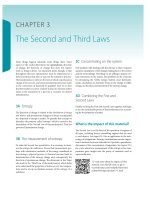Ecomomics evelopment 10th y p todaro and smith chapter 05
Bạn đang xem bản rút gọn của tài liệu. Xem và tải ngay bản đầy đủ của tài liệu tại đây (1.06 MB, 41 trang )
Chapter 5
Poverty,
Inequality, and
Development
Copyright © 2009 Pearson Addison-Wesley. All rights reserved.
Measuring Income Distribution
Relative Income Share:
• The ratio of the highest 20% to lowest 40% of
the population
• The higher the ratio, the greater is income
inequality
Copyright © 2009 Pearson AddisonWesley. All rights reserved.
5-2
Typical Size Distribution of Personal Income
Copyright © 2009 Pearson AddisonWesley. All rights reserved.
5-3
Lorenz Curve of Income Distribution
• Depicting:
quintile percentage of population vs.
cumulative percentage of income received
• The closer the Lorenz curve to the line of equality, the
better is the size distribution of income
Copyright © 2009 Pearson AddisonWesley. All rights reserved.
5-4
Lorenz Curve of Income Distribution
Data for the United States in 2000:
Quintile
% Income
% Cumulative Income
Lowest 20%
3.6
3.6
Second 20%
8.9
12.5
Third 20%
14.9
27.4
Fourth 20%
23.0
50.4
Richest 20%
49.6
100.0
Copyright © 2009 Pearson AddisonWesley. All rights reserved.
5-5
Lorenz Curve of Income Distribution
Copyright © 2009 Pearson AddisonWesley. All rights reserved.
5-6
Lorenz Curve of Income Distribution
The greater the curvature of the Lorenz Curve, the greater is the
Copyright
© 2009inequality
Pearson Addisondegree of income
Wesley. All rights reserved.
5-7
Improved Income Distribution
Copyright © 2009 Pearson AddisonWesley. All rights reserved.
5-8
Worsened Income Distribution
Copyright © 2009 Pearson AddisonWesley. All rights reserved.
5-9
Crossing Lorenz Curves
Copyright © 2009 Pearson AddisonWesley. All rights reserved.
5-10
The Gini Coefficient
Copyright © 2009 Pearson AddisonWesley. All rights reserved.
5-11
The Gini Coefficient
0 < The Gini Coefficient < 1
• 0.41 for U.S.
• 0.30 for Ethiopia
• 0.57 for Brazil
• Gini Coefficient is higher for the OPEC and
Middle-income countries than Low-income
countries
Copyright © 2009 Pearson AddisonWesley. All rights reserved.
5-12
The Gini Coefficient
Income inequality had had a tendency to
increase.
1960
LDCs
0.544 0.602
Low income countries
0.407 0.450
1980
Middle-income countries 0.603 0.569
The OPEC
0.575 0.612
Copyright © 2009 Pearson AddisonWesley. All rights reserved.
5-13
Income Distribution Measures
Copyright © 2009 Pearson AddisonWesley. All rights reserved.
5-14
Income Inequality
Copyright © 2009 Pearson AddisonWesley. All rights reserved.
5-15
Functional Income Distribution
• Assume a traditional economy in which labor is the
only variable input (capital and land are fixed): Output
= Wages + Profits
• Functional income distribution = Wages as a
percentage of Profits
• The higher the ratio, the greater is income equality
Copyright © 2009 Pearson AddisonWesley. All rights reserved.
5-16
Functional Income Distribution
Copyright © 2009 Pearson AddisonWesley. All rights reserved.
5-17
Poverty Gap
Average percent of income shortfall below
the poverty line. Over 10.5% in LDCs
• Latin America & Caribbean: about 9%
• Middle East and North Africa: about 1%
• Sub-Saharan Africa: about 15%
• South Asia: 13%
• China, East Asia & Pacific: 8%
Copyright © 2009 Pearson AddisonWesley. All rights reserved.
5-18
Measuring Poverty Gap
• Poverty and income inequality depend on
type of economic, political and institutional
arrangements according to which rising
national incomes are distributed among
broad segments of a population
• A middle-income country may have a higher
poverty rate and poverty gap than a lowincome country (South Africa vs. Sri Lanka)
Copyright © 2009 Pearson AddisonWesley. All rights reserved.
5-19
Measuring Total Poverty Gap
Copyright © 2009 Pearson AddisonWesley. All rights reserved.
5-20
Growth and Distribution
The “Inverted-U” Kuznets Curve
• Income inequality increases during the early stages of
growth
• Income equality increases during a later stage of
growth with redistribution of income and wealth
Copyright © 2009 Pearson AddisonWesley. All rights reserved.
5-21
The Kuznets Curve
Copyright © 2009 Pearson AddisonWesley. All rights reserved.
5-22
Evidence on Kuznets Curve
• Cross country evidence supports the hypothesis
• Time series data show some countries have
been able to grow and improve income
distribution at the same time
Copyright © 2009 Pearson AddisonWesley. All rights reserved.
5-23
Kuznets Curve in Latin American
Copyright © 2009 Pearson AddisonWesley. All rights reserved.
5-24
Income Inequality Across Time
Copyright © 2009 Pearson AddisonWesley. All rights reserved.
5-25









